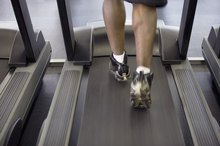What does fact checked mean?
At Healthfully, we strive to deliver objective content that is accurate and up-to-date. Our team periodically reviews articles in order to ensure content quality. The sources cited below consist of evidence from peer-reviewed journals, prominent medical organizations, academic associations, and government data.
- American Heart Association: Target Heart Rates
- American Heart Association: All About Heart Rate (Pulse)
- Cleveland Clinic: Pulse and Target Heart Rate
The information contained on this site is for informational purposes only, and should not be used as a substitute for the advice of a professional health care provider. Please check with the appropriate physician regarding health questions and concerns. Although we strive to deliver accurate and up-to-date information, no guarantee to that effect is made.
Is a Heart Rate of 230 Abnormal During Treadmill Running?
Using a treadmill is an effective way to improve your cardiovascular fitness, but you must always exercise within moderation. Elevating your heart rate excessively can lead to serious health repercussions. Before you step on the treadmill for your next workout, familiarize yourself with how to use the machine's heart rate monitor or get acquainted with checking your own pulse to ensure you keep your heart rate at a safe level. Always consult a doctor before beginning this or any exercise regimen.
Avoid a Rate of 230
Although your heart rate increases as you walk or run on a treadmill, it should never approach 230 beats per minute. This heart rate is extremely high, even for a young person with a high maximum heart rate. The American Heart Association notes a 20-year-old person has a maximum heart rate of 200 beats per minute 23. Regardless of your age, your heart rate during exercise should be significantly lower than 230 beats per minute.
- Although your heart rate increases as you walk or run on a treadmill, it should never approach 230 beats per minute.
- Regardless of your age, your heart rate during exercise should be significantly lower than 230 beats per minute.
Speak to Your Doctor
Side Effects of Tylenol 3 With Codeine
Learn More
You'd have to run with an extremely high level of exertion to raise your heart rate to 230 beats per minute, but taking certain medications in conjunction with strenuous exercise can result in a dangerously high heart rate. Medication for thyroid conditions, for example, can result in an increase in your heart rate. Speak to your doctor about how your medication might affect your heart.
Related Articles
References
- American Heart Association: Target Heart Rates
- American Heart Association: All About Heart Rate (Pulse)
- Cleveland Clinic: Pulse and Target Heart Rate
- Romero SA, Minson CT, Halliwill JR. The cardiovascular system after exercise. J Appl Physiol (1985). 2017;122(4):925–932. doi:10.1152/japplphysiol.00802.2016
- Nystoriak MA, Bhatnagar A. Cardiovascular Effects and Benefits of Exercise. Front Cardiovasc Med. 2018;5:135. Published 2018 Sep 28. doi:10.3389/fcvm.2018.00135
- Füzéki E, Banzer W. Physical Activity Recommendations for Health and Beyond in Currently Inactive Populations. Int J Environ Res Public Health. 2018;15(5):1042. Published 2018 May 22. doi:10.3390/ijerph15051042
- De meersman RE. Heart rate variability and aerobic fitness. Am Heart J. 1993;125(3):726-31. doi: 10.1016/0002-8703(93)90164-5
- American Council on Exercise. Physical Fitness Assessments. Health Coach Manual. 2013.
- American Heart Association. All About Heart Rate (Pulse) January, 2018.
- Nate Brookreson. American College of Sports Medicine. ACSM Certification. "Using Heart Rate Monitoring For Personal Training." July 2015.
Resources
Writer Bio
Toronto-based journalist William McCoy has been writing since 1997, specializing in topics such as sports, nutrition and health. He serves as the Studio's sports and recreation section expert. McCoy is a journalism graduate of Ryerson University.








